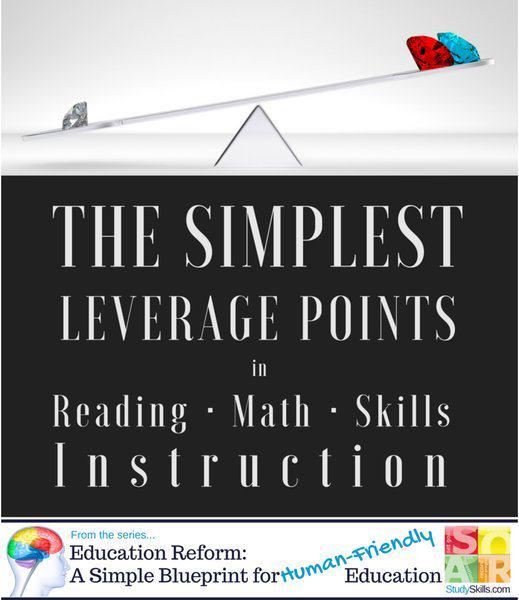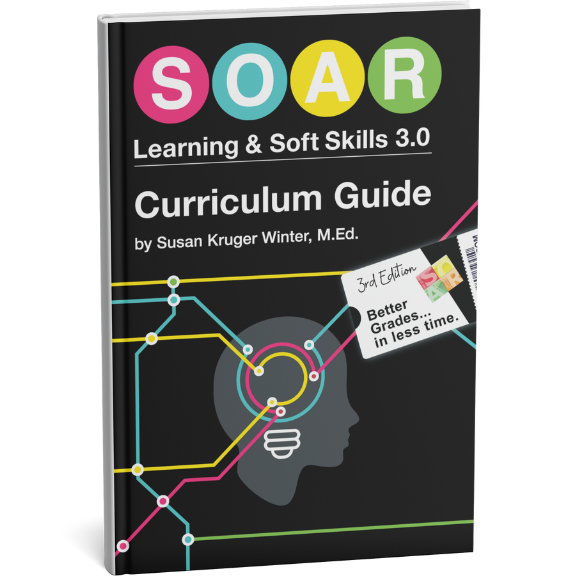The Simplest Leverage Points in Reading, Math, & Skills Instruction
This article is from our series, Education Reform: A Simple Blueprint for Human-Friendly Education. For a directory of all articles in this series, click here. To get the full series in one downloadable PDF, sign-up for the free report in the black box on the right.
 In every core domain of learning (reading/math/skills), there is another core element of effective instruction that is so simple, it is often overlooked. However, we ignore these core elements at great expense to our budgets and the eternal frustration of our greatest asset… our students!
In every core domain of learning (reading/math/skills), there is another core element of effective instruction that is so simple, it is often overlooked. However, we ignore these core elements at great expense to our budgets and the eternal frustration of our greatest asset… our students!
To be clear, the Success Pyramid still applies. We must always approach instruction with the perspective of building confidence for our students (Tier 1) and providing explicit organization instruction (Tier 2). The keys listed below are areas in which to focus instruction when your students are ready to enter Tier 3 of the Success Pyramid: Learning.
Key to Effective Reading Instruction
Reading instruction must be aligned to the circuitry of the brain. The brain utilizes three primary cueing systems to read:
- Visual (Sound-symbol decoding)
- Meaning (Context of the reading material)
- Syntax (“Rhythm” or “cadence” of a sentence; “What sounds right?”)
Effective reading instruction must embrace all three cueing systems. There never should have been an argument between “Phonics” vs “Whole Language.” The answer is… BOTH!
Every reading challenge I have ever encountered as an educator (and as a parent) has been diagnosed and understood according to the three cueing systems. I have explained this framework for reading instruction in my comprehensive but efficiently short book, Cue to Reading.
Key to Effective Math Instruction
We all know math is a progressive subject; one skill builds on another, and another, and so on. What’s missing in most math instruction is the concrete concept before graduating to the conceptual.
Hands-on is key! The hands are an extension of the brain. With hands-on materials, preschoolers can learn algebra!
The intention of “Common Core Math” was to encourage greater conceptual understanding of math. However, most examples of Common Core math implementation have left out the hands-on instruction. (Or, the hands-on instruction is not fully sufficient.)
A thorough and methodical hands-on approach to teaching math builds concrete understanding. Concrete understanding is a critical foundation for success with mathematical concepts.
There is no need to reinvent the wheel. Dr. Montessori accurately predicted that “math literacy” would become as important to the 20th Century and beyond, as language literacy had become in the 18th & 19th centuries. She meticulously developed a thorough, hands-on, curriculum for math.
Once the concrete understanding of math is solid, students would do best to continue math instruction with software that provides immediate feedback. “Mistakes” are powerful learning tools, but only if students get immediate feedback to learn from the process.
Key to Effective Skills
To effectively teach skills, we must align instruction to the circuitry of the brain. This includes skills for: planning, organizing, learning, communicating, and solving problems. We must understand how the brain works, then develop strategies accordingly. This process will ensure maximum efficiency and effectiveness.
When teaching skills for planning and organizing, brain biology requires that we focus on efficiency. The Front Brain manages these skills; it needs strategies with as few steps as possible.
When teaching skills for learning, communicating, and solving problems, brain biology requires that we develop as many connections as possible. The Back Brain manages these skills. The Back Brain thrives on creating as many connections as possible by: creating questions, connecting to previous knowledge/experiences, engaging in real-life experiences, multi-sensory exploration, social interaction, and more.
Conclusion
Small leverage points yield great rewards! The keys to effective instruction can help guide you in your optimal design of instruction and instructional materials.
In the next article, we’ll look forward to Advice from a Futurist…
To our students’ success,
Susan Kruger, M.Ed.
Education Reform: A Simple Blueprint for Human-Friendly Education
This article is from our full report on education reform. Portions of the report will be released on a weekly basis in article form (see the directory below).
However, to access the full report (in its entirety) now, sign-up in the black box on the right.
Education Reform Article Directory:
- Introduction to Education Reform: A Simple Blueprint for Human-Friendly Education
- Three Core Problems with Education in the United States
- The Success Pyramid: A Model of Effective & Efficient Learning
- The Brain Biology of Learning: Why the Success Pyramid Works
- Solutions for Core Problem #1 with Education in the United States
Solutions for Core Problem #2 with Education in the United States
Solutions for Core Problem #3 with Education in the United States - Special Education: It Doesn't Have to Be So Difficult - Part I of III
Special Education: How to Solve & Prevent Learning Disabilities - Part II of III
Special Education: The Brain Biology of ADHD & Autism - Part III of III - Ideal Instructional Models: Successful Examples of Complete Human Education
- Finland: A Political Model of Education Reform
- Why Common Core Is the Worst & BEST Thing to Happen to Education
- The Simplest Leverage Points in Reading, Math, & Skills Instruction
- Looking Forward: Advice from a Futurist
- Conclusion: The Four Principles of Optimal Instruction
- Summary: An Ideal School System
SPECIAL REPORT: To get the full series in one downloadable PDF, sign-up for the free report in the black box on this page.

Six Steps
Conquer the Chaos
Get Our Free Guide & Information on...

"*" indicates required fields
Get Our FREE Curriculum Guide!
The SOAR® Curriculum
The most critical learning, organizing, and communication skills needed for school. Learn more here.
Who’s Using SOAR®?
SOAR® Guarantee
Click here to learn more.





